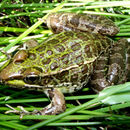Description
provided by AmphibiaWeb articles
This leopard frog attains an adult snout-vent length of 57-95 mm. Its body is fairly stocky, with rugose skin on the back and sides. Dorsolateral folds are present but interrupted posteriorly and displaced medially. The supralabial stripe is incomplete in adults. Vocal sacs are small and external. Grey mottling on the throat may extend onto the chest. The venter is variably melanistic with yellowish pigmentation in the groin region. The posterior of the thigh and the area surrounding the cloaca is covered with small tubercles.(image, http://amphibiaweb.org/images/sound3.gif) Hear calls at the Western Sound Archive (http://content.lib.utah.edu/cdm4/item_viewer.php?CISOROOT=/wss&CISOPTR=964&CISOBOX=1&REC=1).
Platz, J. E. and Mecham, J. S. (1963). ''Rana chiricahuensis.'' Catalogue of American Amphibians and Reptiles. American Society of Ichthyologists and Herpetologists, 347.1-347.2.
Distribution and Habitat
provided by AmphibiaWeb articles
Discontinuously distributed in Arizona, New Mexico, Sonora and Chihuahua. Populations occur in the montane areas of the Mogollon Rim and along the eastern base of the Sierra Madre Occidental. Rana chiricahuensis is found at elevations from 1000-2600 m, and occurs in a variety of permanent aquatic habitats which provide adequate depth for predator escape.

